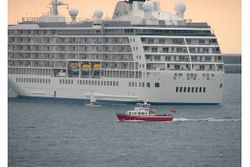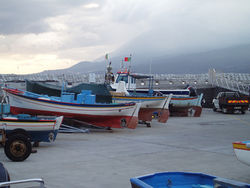Difference between revisions of "Cultural and economic understanding of biodiversity"
Marcin Penk (talk | contribs) |
Dronkers J (talk | contribs) |
||
| (25 intermediate revisions by 4 users not shown) | |||
| Line 1: | Line 1: | ||
| − | {{ | + | {{Review|name=Margaretha Breil |AuthorID=12523}} |
| + | [[Image:Tourist_cruise_Isles_of_Scilly_Marchioni.jpg|right|thumb|250px|caption|Tourist cruise, Isles of Scilly. Source: M. Marchioni]] | ||
Humans conceptualize and understand marine biodiversity in different ways but each of these place value on it. Value in this sense may be monetary in nature, as in economic understandings of biodiversity. But value can also be non-monetary, such as seen in the cultural valuation whereby “importance” is what is really being considered. Efforts to include economic and cultural understandings of biodiversity into management policies use environmental and marine biodiversity valuation studies for including needed data. | Humans conceptualize and understand marine biodiversity in different ways but each of these place value on it. Value in this sense may be monetary in nature, as in economic understandings of biodiversity. But value can also be non-monetary, such as seen in the cultural valuation whereby “importance” is what is really being considered. Efforts to include economic and cultural understandings of biodiversity into management policies use environmental and marine biodiversity valuation studies for including needed data. | ||
| + | |||
| + | [[Image:Whale watching in Pico Faial channel out of Horta.JPG|left|thumb|250px|caption|Whale watching in Pico Faial channel out of Horta. Source: M. Marchioni]] | ||
Assessing the economic value of marine biodiversity has benefited from earlier work in environmental economics; environment is a major topic within the field (link: http://en.wikipedia.org/wiki/Environmental_economics). In environmental economics, | Assessing the economic value of marine biodiversity has benefited from earlier work in environmental economics; environment is a major topic within the field (link: http://en.wikipedia.org/wiki/Environmental_economics). In environmental economics, | ||
| − | “use and indirect use are tangible benefits accruing from natural resources or ecosystem services” (see http://en.wikipedia.org/wiki/Environmental_economics); non-use values include existence, option, and bequest values. People may, for example, place equal value on the existence of numerous species, regardless of the effect of the loss of a single species on ecosystem services | + | “use and indirect use are tangible benefits accruing from natural resources or ecosystem services” (see http://en.wikipedia.org/wiki/Environmental_economics); non-use values include existence, option, and bequest values. People may, for example, place equal value on the existence of numerous species, regardless of the effect of the loss of a single species on ecosystem services. The existence of these species may have an option value, i.e., the potentiality of using it for some human purpose (consumption; pharmaceutical drugs) may exist. At the same time, individuals may also value leaving a pristine environment and species found therein to their children. |
Use and indirect use values can be inferred from actual behavior, such as the cost of taking holiday trips to, for example, Flamborough Head or the Gulf of Gdansk. In this instance, economic values are estimated based on observed prices. Non-use values are usually estimated using stated preference methods such as contingent valuation. “Contingent valuation typically takes the form of surveys in which people are asked how much they would pay to observe and recreate in the environment (willingness to pay) or their willingness to accept (WTA) compensation for the destruction of the environmental good.” (http://en.wikipedia.org/wiki/Environmental_economics). | Use and indirect use values can be inferred from actual behavior, such as the cost of taking holiday trips to, for example, Flamborough Head or the Gulf of Gdansk. In this instance, economic values are estimated based on observed prices. Non-use values are usually estimated using stated preference methods such as contingent valuation. “Contingent valuation typically takes the form of surveys in which people are asked how much they would pay to observe and recreate in the environment (willingness to pay) or their willingness to accept (WTA) compensation for the destruction of the environmental good.” (http://en.wikipedia.org/wiki/Environmental_economics). | ||
| − | Cultural understandings of marine biodiversity are a challenge for many policy makers and researchers due to what is often considered the subjective nature of cultural values and understandings. Linked closely with cultural heritage and identity | + | Cultural understandings of marine biodiversity are a challenge for many policy makers and researchers due to what is often considered the subjective nature of cultural values and understandings. Linked closely with [[cultural heritage and identity]], understandings of marine biodiversity are, for all-intensive-purposes, the importance of biodiversity, species, and eco-system functioning to people’s way of life, identity, heritage, and even quality of life. |
| + | |||
| + | [[Image:Lajes boats Pico Island.jpg|right|thumb|250px|caption|Lajes boats, Pico Island. Source: M. Marchioni]] | ||
| + | |||
| + | The consideration of cultural understanding of biodiversity, opens the view on its importance for a determined part of the society. Importance, albeit in welfare economics commonly expressed in monetary terms, can also attach to social and moral values (Sheil et. al. 2002<ref>Sheil, D., R. Puri., Imam Basuki, M. Van Heist, Syaefuddin, Rukmiyati, M.A. Sardjono, I. Samsoedin, K. Sidiyasa., Chrisandini, E. Permana, E.M. Angi, F. Gatzweler. B. Johnson, and A.Wijaya. | ||
| + | 2002 “Exploring biological diversity, environment and local people’s perspectives in forest landscapes: Methods for a multidisciplinary landscape assessment” CIFOR (Centre for International Forestry Research). | ||
| + | </ref>). As in the MarBEF cultural valuation fieldwork, and in Sheil’s work (2002), cultural importance can often be successfully stated as a statement of relative preference. Cultural perceptions of landscapes, management of resources can contribute to alternative and more effective strategies to ecosystem and biodiversity management (Millennium Ecosystem Assessment<ref>Millennium Ecosystem Assessment | ||
| + | 2005. Ecosystems and Human Well-Being: Policy Responses | ||
| + | Findings of the Responses Working Group, Millennium Ecosystem Assessment Series, vol 3, chapter 14. Island Press. </ref>). A number of Scillonians, for example, pointed out that they are a part of the environment on the Isles of Scilly and if you take them away, the current species composition will change. It is important to keep historical developments and the perspective of communities on their ecosystems in mind when valuing biodiversity through a cultural lens. | ||
| + | |||
| + | |||
| + | ==Related articles== | ||
| + | :[[Multifunctionality and Valuation in coastal zones: concepts, approaches, tools and case studies]] | ||
| + | :[[Multifunctionality and Valuation in coastal zones: introduction]] | ||
| + | :[[Values of amenities in coastal zones]] | ||
| + | :[[Socio-economic evaluation]] | ||
| + | :[[Hedonic Evaluation Approach]] | ||
| + | :[[Total Economic Value]] | ||
| + | :[[Travel cost method]] | ||
| + | :[[Economic valuation of goods and services]] | ||
| + | :[[Economic Value]] | ||
| + | |||
| + | |||
| + | |||
| + | |||
| + | ==References== | ||
| + | <references/> | ||
| − | |||
{{author | {{author | ||
| Line 14: | Line 42: | ||
|AuthorFullName=Delaney, Alyne | |AuthorFullName=Delaney, Alyne | ||
|AuthorName=Alyne}} | |AuthorName=Alyne}} | ||
| + | |||
| + | [[Category:MarBEF Wiki]] | ||
Latest revision as of 15:13, 15 February 2024
Humans conceptualize and understand marine biodiversity in different ways but each of these place value on it. Value in this sense may be monetary in nature, as in economic understandings of biodiversity. But value can also be non-monetary, such as seen in the cultural valuation whereby “importance” is what is really being considered. Efforts to include economic and cultural understandings of biodiversity into management policies use environmental and marine biodiversity valuation studies for including needed data.
Assessing the economic value of marine biodiversity has benefited from earlier work in environmental economics; environment is a major topic within the field (link: http://en.wikipedia.org/wiki/Environmental_economics). In environmental economics, “use and indirect use are tangible benefits accruing from natural resources or ecosystem services” (see http://en.wikipedia.org/wiki/Environmental_economics); non-use values include existence, option, and bequest values. People may, for example, place equal value on the existence of numerous species, regardless of the effect of the loss of a single species on ecosystem services. The existence of these species may have an option value, i.e., the potentiality of using it for some human purpose (consumption; pharmaceutical drugs) may exist. At the same time, individuals may also value leaving a pristine environment and species found therein to their children. Use and indirect use values can be inferred from actual behavior, such as the cost of taking holiday trips to, for example, Flamborough Head or the Gulf of Gdansk. In this instance, economic values are estimated based on observed prices. Non-use values are usually estimated using stated preference methods such as contingent valuation. “Contingent valuation typically takes the form of surveys in which people are asked how much they would pay to observe and recreate in the environment (willingness to pay) or their willingness to accept (WTA) compensation for the destruction of the environmental good.” (http://en.wikipedia.org/wiki/Environmental_economics). Cultural understandings of marine biodiversity are a challenge for many policy makers and researchers due to what is often considered the subjective nature of cultural values and understandings. Linked closely with cultural heritage and identity, understandings of marine biodiversity are, for all-intensive-purposes, the importance of biodiversity, species, and eco-system functioning to people’s way of life, identity, heritage, and even quality of life.
The consideration of cultural understanding of biodiversity, opens the view on its importance for a determined part of the society. Importance, albeit in welfare economics commonly expressed in monetary terms, can also attach to social and moral values (Sheil et. al. 2002[1]). As in the MarBEF cultural valuation fieldwork, and in Sheil’s work (2002), cultural importance can often be successfully stated as a statement of relative preference. Cultural perceptions of landscapes, management of resources can contribute to alternative and more effective strategies to ecosystem and biodiversity management (Millennium Ecosystem Assessment[2]). A number of Scillonians, for example, pointed out that they are a part of the environment on the Isles of Scilly and if you take them away, the current species composition will change. It is important to keep historical developments and the perspective of communities on their ecosystems in mind when valuing biodiversity through a cultural lens.
Related articles
- Multifunctionality and Valuation in coastal zones: concepts, approaches, tools and case studies
- Multifunctionality and Valuation in coastal zones: introduction
- Values of amenities in coastal zones
- Socio-economic evaluation
- Hedonic Evaluation Approach
- Total Economic Value
- Travel cost method
- Economic valuation of goods and services
- Economic Value
References
- ↑ Sheil, D., R. Puri., Imam Basuki, M. Van Heist, Syaefuddin, Rukmiyati, M.A. Sardjono, I. Samsoedin, K. Sidiyasa., Chrisandini, E. Permana, E.M. Angi, F. Gatzweler. B. Johnson, and A.Wijaya. 2002 “Exploring biological diversity, environment and local people’s perspectives in forest landscapes: Methods for a multidisciplinary landscape assessment” CIFOR (Centre for International Forestry Research).
- ↑ Millennium Ecosystem Assessment 2005. Ecosystems and Human Well-Being: Policy Responses Findings of the Responses Working Group, Millennium Ecosystem Assessment Series, vol 3, chapter 14. Island Press.
Please note that others may also have edited the contents of this article.
|


